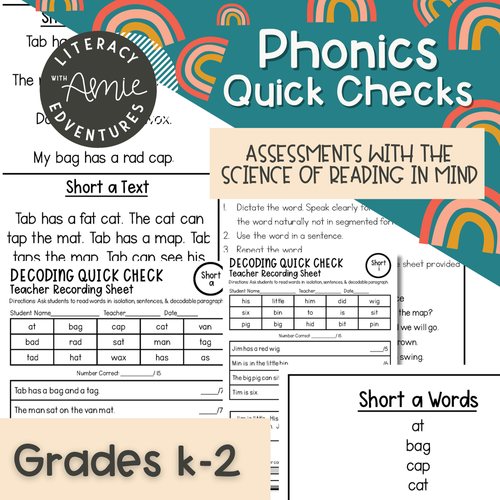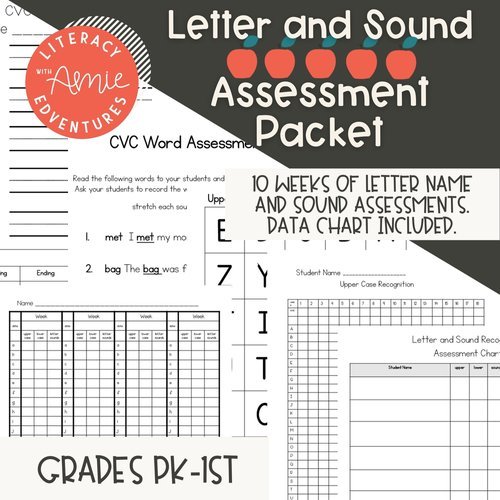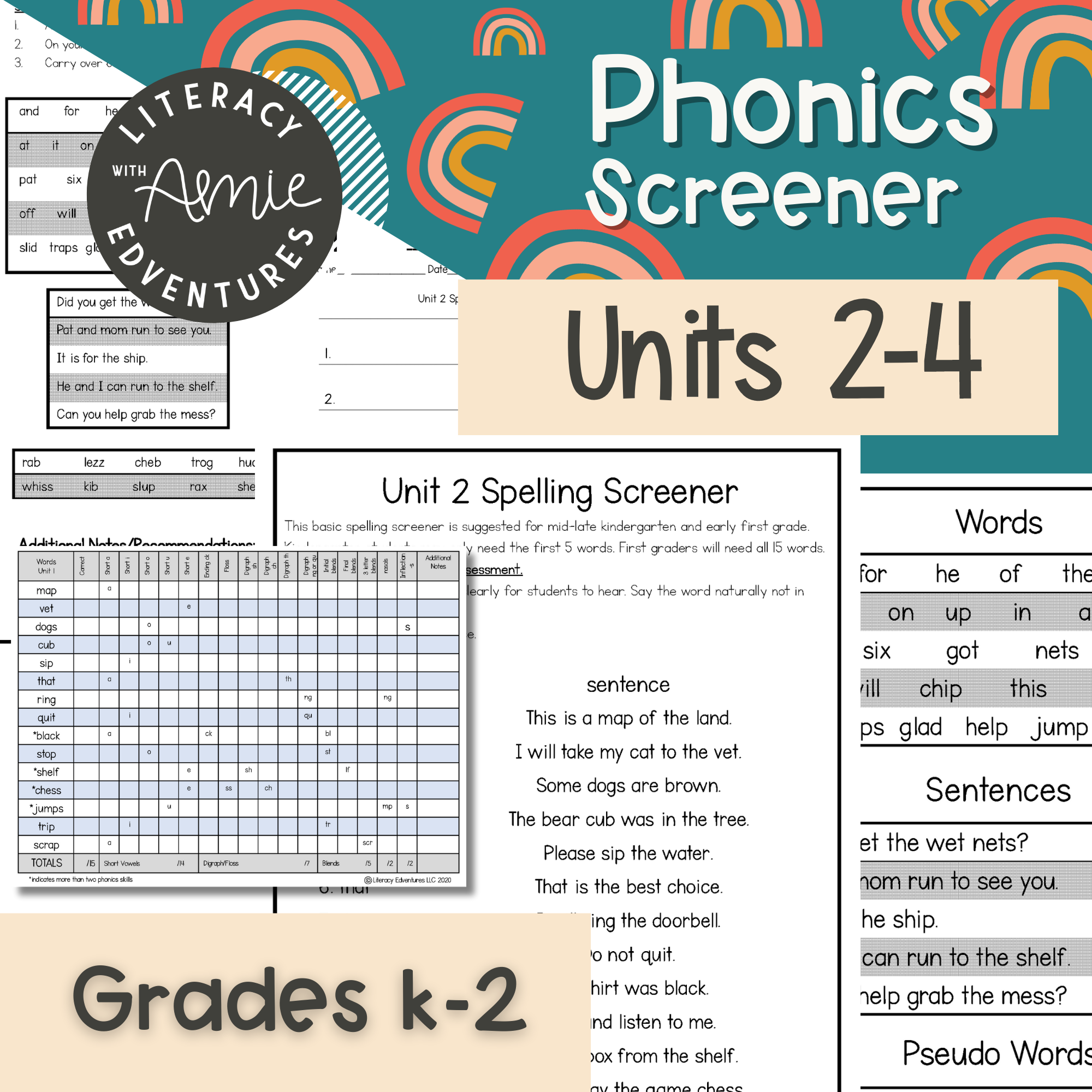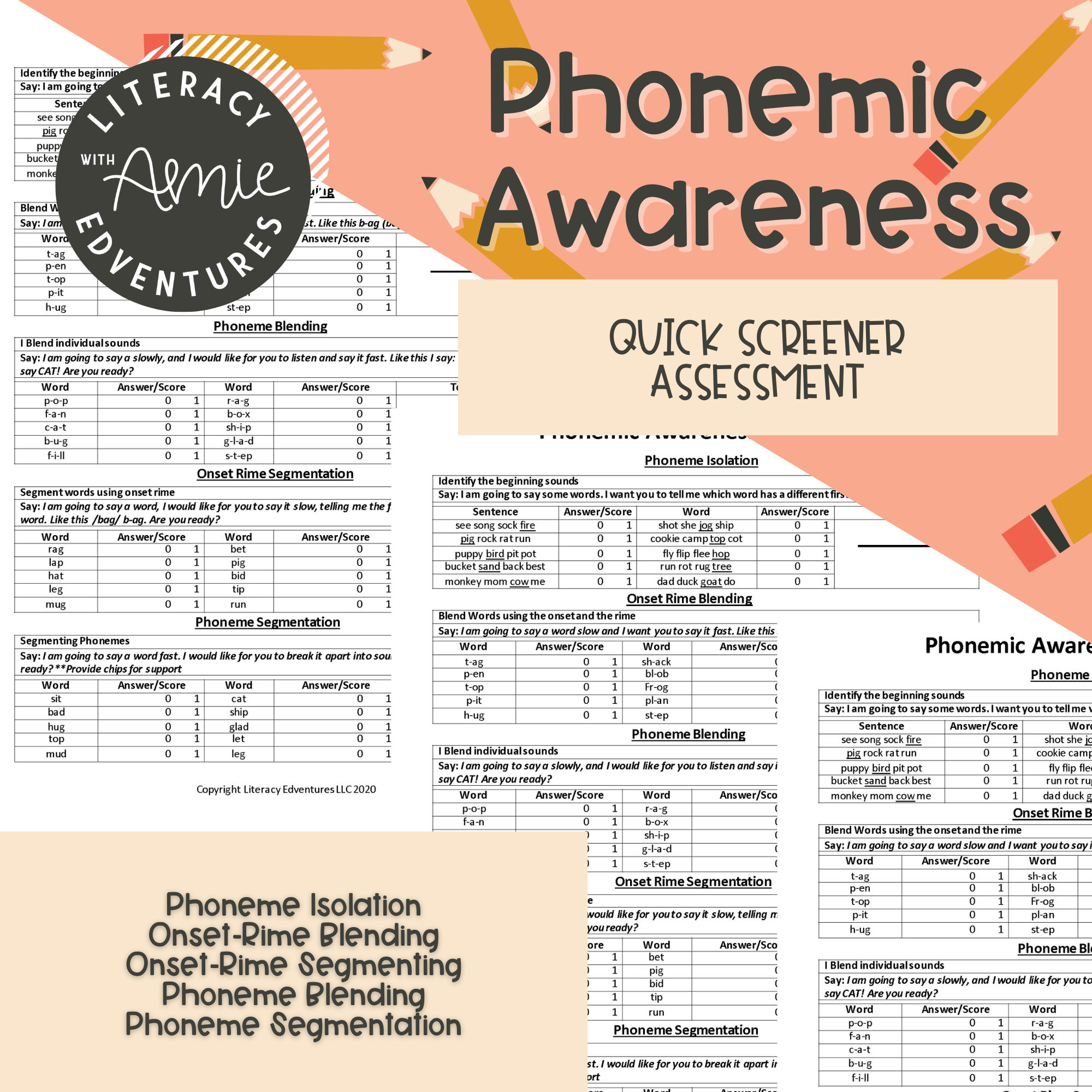Using Assessments to Drive Instruction
When we hear about the science of reading, our first thought is instruction! But there’s one missing piece that slips under the radar: assessment.One common question that’s always asked when talking about the science of reading is, “Where do I start my instruction?” The answer is assessments, and today, I’m here to go over all there is to know about them and their importance.
One of the parts I love most about my job is giving assessments. I love diagnosing exactly what my students need when it comes to growing them as a reader. Assessment is an essential component of the education system. It doesn’t matter if you teach kindergarten or high school or biology or reading - assessments are part of the foundation of education. The first step to good instruction is determining what students need, and we do this by - yep, you guessed it - assessments!
It seems obvious, right? But when we go looking through activities and ideas for lessons, we often haven’t done what we need to do first, which is to ask ourselves, “What do my students need?” Teachers must determine that baseline before we go off to give our students instruction. Students enter classrooms with backgrounds and skills of all different kinds. One may require special needs, while another may enter your classroom having already mastered the content you plan to cover! Since each classroom is a mixed bag, we need to design our instruction to meet the needs of our students. We meet these needs by implementing assessments - both at the beginning of the year and throughout.
As we read, let’s keep a few points in mind:
Each assessment serves a different purpose.
The assessments we are using need to be closely linked to our instruction and should be the driving force behind our instruction.
The data from these assessments must answer the questions we have about our students and those questions must drive our instruction.
We need to be informed of what assessments are out there and how each one can help us in different ways.
With these things in mind, let’s dive in!
Three Main Types of Assessments
Universal screener (otherwise known as benchmarks)- This is where we start. We do these assessments with all students and they tell us which students are on track and which are struggling. And when we find out which of our students are struggling, we then give a…
Diagnostic assessment - This is a pre-assessment or pre-test where teachers can evaluate students’ knowledge of skills before instructing on that skill. This test focuses on a student’s strengths and weaknesses. They’re usually casual, low stakes, and don’t count for a grade.
Progress monitoring - We use these assessments to ensure that our interventions are working.
When we know how each assessment works, then we can figure out which assessment to use and when. When we start with a universal screener, something we must keep in mind is that whether fast or slow or somewhere in between, everyone learns to read in the same way. Some students get to fluency and comprehension quicker than others, while other students take more time. It is our universal screeners (our benchmark assessments) that show us who is separated from the pack. Universal screeners will be our first indication of struggling readers.
When we get these results that show us that certain students are struggling, we have to do a further assessment to see exactly what they need - it’s like playing detective! Here’s a scenario: Let’s say that you have a student who’s in third grade and he or she takes a universal screener that determines comprehension skills. If that student does poorly on the assessment, we need to figure out why. Are they able to read the text and are they genuinely struggling with comprehension? Or did they do poorly because they couldn't access the text and are struggling with something else? Perhaps they struggle with fluency, decoding, or even letter sounds. This is why we need further assessments so we can understand their specific weakness.
These “further assessments” are our diagnostic screeners. I’m going to share with you some of my favorite diagnostic screeners that show areas of weakness. These screeners are going to be so beneficial to your classroom because they truly target the area of need for your students.
Go-To Diagnostic Assessments
Phonological Awareness Assessment - This type of assessment is used to assess a students’ ability to hear and manipulate sounds. As we know, this skill is a prerequisite for reading and an indication of later reading difficulties. This should be used as a formative assessment so you can know where you can start your instruction. Because phonological awareness is developmental and it occurs on a continuum, I’ve attached one here to help you pinpoint where to start your students after you’ve given the assessment. And remember - though many students might need to start at blending and segmenting, some of your students might actually need to start at the syllable or onset-rime level. It’s these skills that they will need in order to blend and segment.
When you go back to your phonological awareness continuum, they begin with the larger units of sound, such as sentences, syllables, and onset-rime. Then, they move on to blending and segmenting. This continuum shows the progression that most students take through phonological awareness - it is not there to show you a step-by-step process. We can’t just see that a student is struggling and start them at the beginning because remember - we need students to blend and segment as soon as they can. But let’s say you ask a student, “My word is b-a-t. What’s my word?” If they’re unable to repeat it back to you, then you must back up to the onset-rime level. If not that, then back up to the syllable level. Not even that? Then we’re beginning with compound words. “My word is foot-ball. What’s my word?” Having this assessment is key to knowing where to start on the continuum. We don’t just want to automatically start them back at the beginning.Phonics, Spelling, Letter Sound Assessments - Teachers can gain so much knowledge about where a student is at by asking them how to spell a word. Since letter sounds and phonemic awareness are important when it comes to decoding and phonics, using assessments like these will showcase areas of phonic weakness. When giving a phonics and spelling assessment, teachers should be doing it through a predetermined list of words based upon the instruction that’s going to take place within the walls of their classroom. This allows you to see specific areas of weakness. For example, if you ask a student to spell the word glad, and he or she spells g-a-d, then you know you might need to begin instruction with beginning blends. Be sure that whatever screener you use, it should be tightly linked with your phonics continuum as well. If you’re looking for a spelling screener, I’ve got one for ya!
Now let’s talk about letter sound knowledge. If you’ve asked a student to spell a word and they’re unable to, we then need to figure out what letter sounds they do know. We must figure out what letter sounds are missing from their repertoire in order to improve their reading and spelling. If students aren’t able to spell words, then we need to figure out what letter sounds they know. This is where letter sound assessments will be particularly helpful. And it isn’t just spelling that we should be focusing on either, but also word recognition.Word Recognition Assessments - If students are able to decode words with a specific skill, then that means they understand the skill. If a student can read the word rain, then they understand that the ai sound makes the long a sound. But let’s not forget about our overcompensaters. You’ve heard me talk about these students before. These are the students that come to our 3rd and 4th grade classrooms who struggle with reading because until then, they’ve memorized words. This is because they either don’t have a strong phonics foundation or didn’t see the connection.
During a screener, if students are asked to decode words (whether they be real or nonsense), they’re really showing off their sound-to-symbol correspondence. At this point, we’ve already asked them to spell (encode), but now we’re asking them to read (decode). We need to see if they can accomplish this and at what level. Are they reading at a CVC word level or a diphthong level? Do their skills line up with what they’re able to spell (encode)? Or are they lagging?
Afterwards isolation, it’s time to move on to word recognition in context. This tells us if they’re able to read words in context and how well they’re able to do it. We of course want them to decode words, but what we’re really looking for ultimately is for them to decode automatically in context as they’re reading a passage. Decodable sentences are a good assessment for this to start, then graduating students onto longer passages.
The Benefit of Fluency Screeners
Do you remember that third grader who I mentioned at the beginning of this post who struggled with comprehension? Let’s clarify something with that example. When something like this happens, I wouldn’t necessarily recommend going straight to a letter sound assessment, or a phonological awareness assessment, or even a phonics screener with this third grader. Rather, I would start with a timed fluency screener. We know that fluency leads to good comprehension, so giving them a short, one-minute fluency screener will tell us how fluency this student is. Does he or she struggle with comprehension or is he or she struggling to access the text?
With a fluency screener, I’m able to see how many words they’re reading per minute (and accurately), how their sentences sound (are they smooth or are they labored?), and how well they’re able to decode words. If they end up struggling with this, simply note their struggles and give them a spelling or phonological awareness assessment to see where their skills fall on the continuum.
It’s absolutely vital that the assessments you’re choosing are at the developmental abilities of the students so that the data can reflect their areas of strength and weakness. If you’re teaching kindergarten, you know that your younger readers are focused on letter sounds, phonemic awareness, and word recognition. So, choose those assessments! If you’re teaching older students, consider whipping out a fluency screener at first when you see a child struggle. Remember that assessments should drive our instruction. At the same time, take heart and know that you don’t have to do every single assessment with every single student. These are meant to be more of a diagnostic for those struggling students who are recognized after that universal screening.





